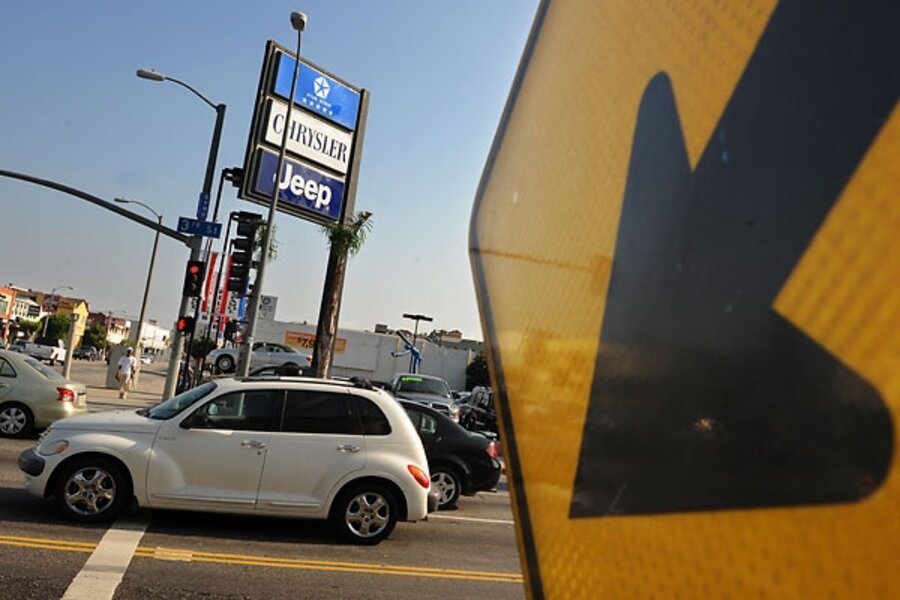Deal with creditors may let Chrysler veer out of bankruptcy
Loading...
Chrysler may be getting a new lease on life.
First came a deal over the weekend with the United Auto Workers to cut labor costs. Now comes word that the company has struck a deal with creditors to lighten its debt burden.
Coupled with a still-pending alliance with Fiat, the moves may be enough to help the smallest of the Detroit Three carmakers avoid bankruptcy and secure additional loans from the US government.
If these elements of restructuring all come together, it would represent a U-turn for a company that, just a week ago, appeared close to a liquidation-style bankruptcy.
The outlook for Chrysler, while still uncertain, has brightened considerably with two days to go before a government-imposed deadline for restructuring.
It could be yet another revival for a company that has been on the brink of failure numerous times, even as it has carved out a reputation for innovative designs.
“It’s a big plus for Chrysler not to have to go through bankruptcy,” says Peter Morici, a University of Maryland economist who follows the industry.
He worries, however, that Chrysler’s latest restructuring effort won’t be enough to make the company truly viable.
The risk is that even if the firm avoids bankruptcy now, it will be knocking at the Obama administration’s door again before the auto industry’s slump is over. In recent months, Chrysler has been subsisting largely on $4 billion in Treasury loans.
A deal with creditors
Still, the latest ray of hope for Chrysler is a significant one. In a deal with the Treasury, some of Chrysler’s biggest creditors agreed to swap $6.9 billion debt for $2 billion in cash. The agreement, not yet formally announced, has been reported by the Associated Press and other news organizations.
The Treasury still needs to get dozens of additional creditors, from banks to hedge funds, to sign on. Otherwise, it’s still possible the firm will face a bankruptcy proceeding where a judge can consider the creditors' claims, according to the AP.
Agreements with the union and with creditors could open the way for a deal with Fiat. The Italian carmaker is looking to broaden its reach in the US market. An Obama administration task force, trying to help the US car industry survive a deep downturn, told Chrysler a month ago that it needed a global partner to be viable and worthy of additional government aid.
The task force was blunt in its assessment of the company’s problems with quality and its lack of global marketing.
“Chrysler’s limited scale in an increasingly capital-intensive global business, the inferior quality of its existing product portfolio, and its heavy truck mix leave the Company poorly positioned,” the task force said.
The task force was less optimistic about Chrysler’s survival than about prospects for General Motors (GM), the largest of the Detroit Three.
The Obama panel gave GM 60 days to come up with its viability plan, and implied that even if the company enters bankruptcy for a time, the firm will not face outright liquidation. The critique of Chrysler came with tougher words and a shorter deadline.
But both firms face similar challenges.
Investors shortchanged?
GM hopes to survive by asking its union and its lenders to exchange existing obligations for an ownership stake. In turn, the government would agree to provide more aid. Current shareholders would be nearly wiped out, left with just a sliver of an ownership stake.
Ford, the second largest US carmaker, is also restructuring its debt and union obligations, but without government aid.
Chrysler's owner, the private-equity firm Cerberus, would see its stake decimated in a restructuring, as would GM's stakeholders.
The pivotal role played by creditors is clear at both GM and Chrysler. On Monday, GM announced its own new downsizing plan – designed to convince the Treasury of its viability.
But investors in GM’s bonds expressed concern that they are being shortchanged by the Obama administration and the carmaker.
“The union’s [healthcare trust] would receive a 50 percent recovery in cash and a 39 percent stake in a new GM for its $20 billion in obligations,” an ad hoc committee of GM bond holders said in a statement Monday. Meanwhile investors such as pension funds “who own more than $27 billion in GM bonds and have the same legal rights as the unions, would only receive a mere 10 percent of the restructured company and essentially no cash.”
Profitability still far off
However the dealmaking goes from here, all three US-based carmakers face a tough fight to get back to profitability.
“I don’t think they’re going to have a viable company,” Mr. Morici, of the University of Maryland, says of Chrysler. Even after the latest cost-cutting deal, he says, “the labor contract still leaves them uncompetitive.”
Where GM is slimming down its brand portfolio, Chrysler has already pared down to just three names – Dodge, Chrysler, and Jeep.
“They’re down to the minimum number of brands. The Plymouths are gone,” Morici says. But like GM, “they really need fewer dealers.”





